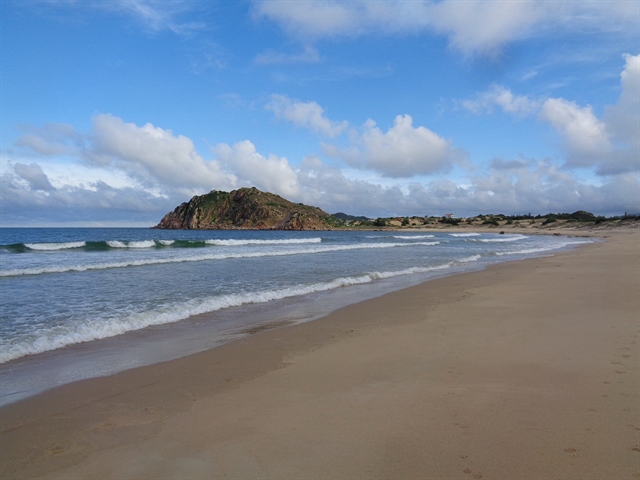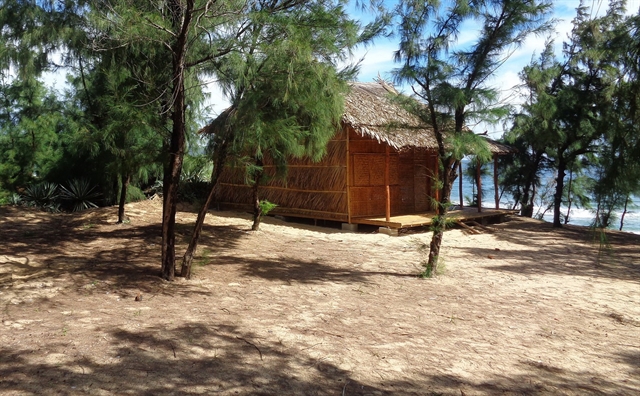Weather:
- Ha Noi 26oC
- Da Nang 27oC
- Ho Chi Minh 26oC

Mỹ Duyên
Leaving the airport near the central coastal city of Quy Nhơn, we embarked by car on National Highway 1D southward to Cù Mông Pass in Phú Yên Province, a central coastal area famed for its seductively sandy beaches and peaceful fishing villages.
It was early morning and the highway was all but deserted. The surrounding countryside was a sparkling lush green and we could feel the freshness of the ocean air.
Before reaching the Cù Mông Lagoon in the province's Sông Cầu Town, instead of eating breakfast at the roadside restaurants famous for local specialties (green bean and pork porridge, boiled liver, and organ meats served with bánh hỏi or rice noodle cakes, herbs and sweet-and-sour fish sauce), we stopped to take photos on the Cù Mông Pass, a gateway to the central coastal region.
From here, the entire area, including a long sandy beach coastline, beach hideaways and fishing villages below the Cù Mông Pass, can be explored by visitors.
The winding 6km village road was small enough for a car leading to Hoa Lan Resort, which is located in Hòa Lợi Village in Xuân Cảnh Commune (a one-hour drive from the Phù Cát Airport) offered a glimpse of the area’s natural beauty and local traditions.
The surrounding landscape of rice fields, sandy hills and farms raising lobsters, snails and green mussels, all created a vivid picture of the area’s rural lifestyle.
Before arriving at Hoa Lan, we had to pass the Xuân Cảnh Bridge which crosses over the Cù Mông Lagoon, famed for its lobster-rearing farms and its splendid landscape.
Here, tourists can stay with villagers in a simple homestay or relax at Hoa Lan Resort’s bungalows.
At the idyllic beach of Hòa Lợi Village, also known as Bãi Chỏ in Xuân Cảnh Commune, the resort offers six bungalows that respect the environment and the preservation of fauna and flora.
“Instead of noisy and energy-intensive air conditioning, we wanted to build a traditional Vietnamese habitat, providing all the necessary comfort for your well-being with some modern amenities such as a fan and a refrigerator,” said Pierre Relave, the resort’s manager.
“To ensure your peace and privacy, the cabins are spaced at least 10 metres apart, giving you a real private space. Also, we chose not to install a television. But don’t worry, free wifi access throughout the site will ensure you remain ‘connected’ if you wish.”
“Việt Nam is the perfect destination for those seeking a comfortable and relaxing holiday,” he added. “This country of ancient civilisation and its people are extremely kind and they will charm you. The culture, traditions, cuisine and lifestyle here will enchant you.”
The resort offers an “all-organised” stay that ensures you are taken care of from your landing in Việt Nam in Hà Nội or HCM City to your return flight.
Overlooking the ocean, the resort is fronted by a beautiful sandy beach, surrounded by small sandy hills, small cliffs and a residential area. The small village road leading to the resort’s entrance offers guests a splendid view of the entire area, including the Cù Mông Lagoon and green fields.

The resort’s six bungalows are built in a Vietnamese country style cottage with a secluded beachfront, giving the place a true hideaway sensation.
“All of the bungalows were designed to ensure that visitors enjoy the ultimate beachfront lifestyle with a tropical ambience of well-being, where the daily stress of modern living can be forgotten,” Pierre said.
The main small building of the resort, which overlooks the ocean, has a small restaurant and bar where guests can eat a meal together like a big family.
The restaurant offers a wide selection of Vietnamese and European dishes.
“We have chosen to focus on the local economy. You can taste the seafood brought in the morning by fishermen from the village,” Relave said. “Favouring the local economy, we are working with fishermen, ranchers and growers of the region. We restrict imports to a minimum of products not found on site.”
With Sông Cầu Town famous for its seafood, especially lobsters, flower crabs and snails, freshly caught grilled lobster, fish and steamed snails are specialties of the restaurants in the area.
Taking advantage of all the resort is able to offer, in the early morning we warmed up by walking along the beach before swimming in the peaceful sea while a few others took to the beach after watching the sun rise.
Exploring the hideaway’s surroundings is an alternative for those who are more physically active. In the late afternoon, travel lovers can walk in the village to view shrimp farms around the Cù Mông Lagoon, which can offer interesting insights into the local culture.
In the afternoon, you can choose to watch the sun set behind the ocean. By late afternoon, tourists can take a boat tour arranged by Hoa Lan Resort, departing from the beach to view the sea, rocks and shrimp farms around the Cù Mông Lagoon.
You’ll see a stunning blue sea with a few local residents netting fish in the ocean.
Later in the day before dinner, we took a car to visit a small roadside restaurant in Hòa Phú Village near the Bình Phú Bridge in Xuân Cảnh Commune, about a 10-minute drive from the resort, an area famous for its seafood, particularly snails and flower crabs.
While waiting for our order of “perfume” and “jump” snails, we walked down to the aquaculture floating cages where fish, snails and crabs were being raised and stored.
We were back to our table when the food was ready to serve.
The snails, which cost only two-thirds of the price of similar dishes in HCM City, were the freshest I had ever eaten.
After a hard, long day of touring, we were a bit tired. But before retiring to bed a little early, we had a very special dinner with other guests at the resort, just as if we were members of a family though we had never met before. — VNS

